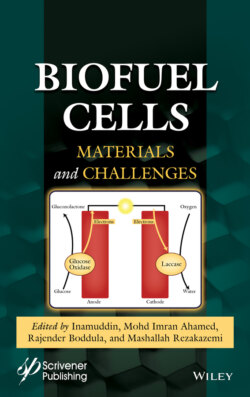Читать книгу Biofuel Cells - Группа авторов - Страница 18
1.4 Supports for Immobilization of Enzymes and Microorganisms for Biofuel Cells
ОглавлениеThe development of biofuel cells, BFCs (enzymatic fuel cells and microbial fuel cells) are of great interest as was mentioned above. The main limitations of these devices are their short lifetimes and low-power density associated with different losses (Figure 1.7). These limitations are related to the issues raised during immobilization of biocatalysts on electrodes to enable a direct electron transfer. At present, many reported BFCs employ redox mediators as electron shuttles involving the addition of an extra interface between the fuel and the solid electrode. Moreover, mediators are typically expensive, unstable and potentially toxic [85].
Therefore, one of the efforts to increase the life-time and power density is related to the development of nanomaterials, which facilities the electron transfer between the enzymes/microbes and the electrode [86–89]. For this purpose, the morphological and electronic characteristics of nanomaterials must decrease the different losses displayed in Figure 1.7a. At the same time, the nature of the nanomaterial must be smartly selected since biocompatibility and toxicity are highly important in microbial fuel cells; antibacterial materials can cause losses of activity and durability. According to the science of materials, the modifications that can be done to a support can be classified as morphological or electronic (Figure 1.8). The most commonly reported supports for BFCs are carbon allotropes because they are nontoxic, abundant, cheap, and easy to prepare and to reproduce [90–92]. The effect of nanomaterials on the performance of BFCs is directly related to the changes in the affinity between the biocatalyst and the nanomaterial from a point of view of adsorption and chemical integration [85]. The increase in surface area boosts the contact points of the biocatalyst, improving the electron flow from the fuel to the electrode and the diffusion of mediators in the electrodes. There are several reviews dealing with the use of nanomaterials in BFCs [6–14, 90–98]; however, in the following pages the use of supports will be covered from a materials science point of view dealing with the latest findings (2017–to date).
Figure 1.7 (a) Schematic representation of a polarization curve for an ideal and a real BFC, and (b) representation of current density and potential losses during time.
In general, the classification of the reported nanomaterials for BFCs is presented in Figure 1.9; being carbon allotropes the most reported materials. Carbon materials that are of high interest in BFCs in recent years are buckypaper, carbon paper and nitrogen-doped graphene. Therefore, the discussion will be centered on them.
Figure 1.8 Structural and electronic modifications of supports to improve the electrocatalytic properties in biofuel cells.
Figure 1.9 Types of supports reported for biofuel cells.
